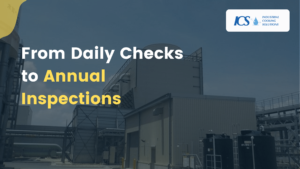Table of Contents
ToggleA Step-by-Step Cooling Tower Maintenance Checklist for Optimal Performance
Cooling towers play a crucial role in maintaining optimal temperatures for various industrial processes, including power generation, petrochemical, chemical, process and HVAC systems. These cooling towers are responsible for dissipating excess heat into the atmosphere. Like any mechanical system, cooling towers demand regular maintenance to ensure their longevity and efficiency. Importantly, neglecting maintenance can lead to decreased efficiency, costly repairs, and potential safety hazards. This blog post contains a simple and comprehensive step-by-step cooling tower maintenance checklist that will help you keep your cooling tower operating efficiently and smoothly. This useful checklist will help you gain valuable insights into maintaining your cooling tower, maximizing its performance, and extending its lifespan. Let's dive in and explore the essential steps to keep your cooling tower maintenance checklist to see if it is running smoothly and efficiently.What is a Cooling Tower?
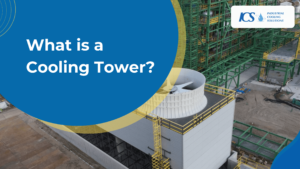 A cooling tower is a large, open-air device designed to cool process hot water or other fluids by extracting the heat and releasing it into the atmosphere. Cooling towers can be forced draft, induced draft or natural draft and can be found in industrial & power plants, refineries, and even large commercial buildings.
A cooling tower is a large, open-air device designed to cool process hot water or other fluids by extracting the heat and releasing it into the atmosphere. Cooling towers can be forced draft, induced draft or natural draft and can be found in industrial & power plants, refineries, and even large commercial buildings.
Understanding the Key Components
A cooling tower consists of the following main elements:- Fan System: Responsible for creating the airflow necessary for heat dissipation.
- Drift Eliminators: These specialized components prevent water droplets from being carried away by the exhaust air.
- Fill Material: It facilitates heat transfer by maximizing contact between air and water, promoting efficient cooling.
- Water Distribution System: Distributes water evenly across the fill material to ensure optimal cooling efficiency.
- Basin and Sump: The basin collects and holds water for recirculation, while the sump allows for proper drainage.A Step-by-Step Cooling Tower Maintenance Checklist
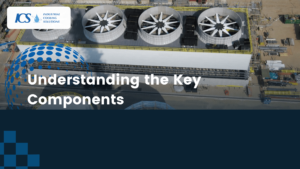 Regular maintenance of cooling towers is vital for their efficient operation and longevity. Here is the step-by-step checklist, that can help keep your cooling tower in optimal condition. So check out the below steps.
Regular maintenance of cooling towers is vital for their efficient operation and longevity. Here is the step-by-step checklist, that can help keep your cooling tower in optimal condition. So check out the below steps.
Step 1: Inspect the Tower Exterior
Start by conducting a visual inspection of the cooling tower's exterior. Look for any signs of physical damage, corrosion, or leaks. Check the structural integrity, fan blades, louvers, and access doors. If you spot any issues, make a note for further investigation or repair. Is the water flow even across the entire "rain zone"? If not, you know there's a possibility of broken nozzles, clogged fill or other issues of concern.Step 2: Clean the Basin and Sump
The cooling tower is a highly effective air scrubber so the cooling tower's cold water basin and sump are susceptible to debris buildup, sediment, and microbiological growth. Begin by draining and cleaning the basin thoroughly. Remove any accumulated dirt, leaves, or other foreign objects. Use a suitable biocide or cleaning agent to eliminate bacteria, algae, and fungi that can lead to fouling and reduced performance.Step 3: Check the Water Treatment System
Proper water treatment is essential to prevent scale, corrosion, and biological growth within the cooling tower system. Inspect the water treatment equipment, including chemical feeders, filters, and pH control systems. Ensure that the equipment is functioning correctly, and adjust chemical dosing rates as needed.Step 4: Examine Drift Eliminators and Fill Material
Drift eliminators and fill material play vital roles in optimizing the cooling tower's efficiency. Inspect these components for any blockages, obstructions, or signs of wear and tear. Clear any debris or scaling from the drift eliminators and ensure that the fill material is intact and evenly distributing water throughout each cell.Step 5: Check the Fan System
The fan system is crucial for proper airflow and heat dissipation. Inspect the blades of fan for any damage or imbalance. Verify that the fan motor, coupling and gearbox are in good condition and properly aligned. Lubricate bearings and change gearbox oil as recommended by the manufacturer.Step 6: Inspect the Water Distribution System
The water distribution system ensures even water flows over the fill material. Check for clogged or malfunctioning spray nozzles. Adjust or replace any faulty nozzles to maintain consistent water distribution and prevent dry spots which cause inefficient cooling.Step 7: Clean and Inspect the Water Piping
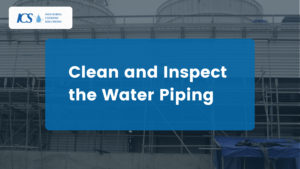 Examine the water piping system for leaks, corrosion, or blockages. Remove any scale or deposits that may have accumulated. Check valves, fittings, and couplings for proper operation and tightness. Repair or replace any damaged components as necessary.
Examine the water piping system for leaks, corrosion, or blockages. Remove any scale or deposits that may have accumulated. Check valves, fittings, and couplings for proper operation and tightness. Repair or replace any damaged components as necessary.
Step 8: Test Water Quality
Regular water quality testing is crucial to monitor parameters such as pH, conductivity, and total dissolved solids (TDS). Collect water samples and conduct tests using appropriate testing kits or send them to a certified laboratory. Moreover, adjust water treatment parameters based on the results to maintain optimal conditions.Step 9: Document and Schedule Maintenance Tasks
Keep detailed records of all maintenance activities, including inspections, repairs, and water treatment adjustments. Create a maintenance schedule based on the manufacturer's recommendations and your observations. Thus, regularly review and update the schedule to ensure timely and proactive maintenance.Comprehensive Cooling Tower Maintenance Checklist: From Daily Checks to Annual Inspections
Daily
- Check for any visible leaks, unusual noises, or vibrations.
- Inspect the water level and ensure it's within the recommended range.
- Monitor water temperature and pressure gauges.
- Check fan operation and ensure proper operation.
- walk the perimeter of the tower to inspect balance in the rain zone.w
Quarterly
- Conduct a thorough inspection of the tower's exterior, including structural integrity, fan blades, and louvers.
- Check and clean water strainers or filters.
- Inspect and lubricate fan motor bearings and gearbox oil levels & condition..
- Test water quality parameters such as pH, conductivity, and TDS.
Semi Annually
- Conduct a comprehensive inspection of the water distribution system, including pipes, valves, and fittings.
- Inspect fill material for any signs of damage or fouling.
- Verify alignment couplings in the fan system.
- Clean or replace any clogged or damaged spray nozzles.
Annually
- Perform a detailed inspection of the entire cooling tower system, including mechanical and electrical components.
- check fan blades for cracks, balance and alignment.
- weigh selected fill blocks from lower levels & record weights to measure fouling.
- Inspect and clean water basins and sumps.
- Check and adjust the water treatment system, including chemical feeders and control equipment.
- Conduct a thorough cleaning and inspection of water piping and associated equipment.
Preparing the Cooling Tower for Non-Operational Periods
 Before shutting down the cooling tower for an extended period, it's crucial to take the following steps:
Before shutting down the cooling tower for an extended period, it's crucial to take the following steps:
Thorough Cleaning
Clean the entire cooling tower system, including the basin, sump, fill material, and water distribution system. Remove any debris, sediment, or biological growth that may have accumulated. This helps prevent corrosion, fouling, and the proliferation of harmful microorganisms.Drain the System
Completely drain the cooling tower system to remove all water. This minimizes the risk of stagnant water, which can lead to bacterial growth, scale formation, and corrosion. Ensure that the system is dry and free of moisture before proceeding.Inspect and Repair
Conduct a comprehensive inspection of the cooling tower components. Look for any signs of damage, such as cracks, leaks, or worn-out parts. Address and repair these issues before the idle period to prevent further deterioration. However, if the cooling tower parts are too damaged to perform their work, focus on replacing them for maximum work efficiency and long-lasting.The Importance of Preventative Maintenance
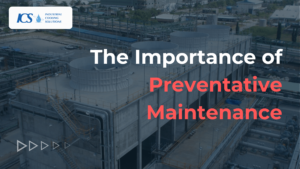 Like any mechanical system, cooling towers require regular maintenance to ensure their efficiency and longevity. Following, we explore why their preventative maintenance is of utmost importance.
Like any mechanical system, cooling towers require regular maintenance to ensure their efficiency and longevity. Following, we explore why their preventative maintenance is of utmost importance.
Efficiency and Performance
Regular maintenance ensures that towers continue to operate at peak efficiency. Over time, mineral deposits, sediment, and biological growth can accumulate within the tower, hindering heat transfer. This reduces the cooling capacity and overall performance of the tower. By conducting routine inspections, cleaning, and preventive maintenance, these issues can be identified and addressed promptly, allowing the tower to function optimally.Preventing Equipment Damage
Cooling towers are interconnected with expensive and critical machinery. Neglecting maintenance can lead to severe consequences, such as equipment failure, plant downtime, and costly repairs. For example, untreated water in the tower can cause corrosion and fouling in the system, leading to more serious damage to the overall system. Routine maintenance, including water treatment and corrosion control measures, helps safeguard the entire cooling system, ensuring its longevity and uninterrupted operation.Ensuring Regulatory Compliance
Many countries have specific regulations and guidelines in place to ensure the safe operation of cooling towers, particularly regarding water quality and emissions. Regular maintenance plays a crucial role in meeting these compliance standards. By conducting routine inspections, monitoring water chemistry, and implementing necessary modifications, companies can avoid penalties, legal complications, and negative impacts on their reputation.Energy Efficiency and Cost Savings
Well-maintained towers consume less energy, resulting in substantial cost savings for industries. A fouled or poorly maintained tower requires more power to achieve the desired cooling effect, increasing energy consumption and utility bills. Regular maintenance, including cleaning of heat exchange surfaces and optimizing water treatment, helps maintain efficient heat transfer, reducing energy usage, and lowering operational costs.Health and Environmental Concerns
Neglected cooling towers can transform into ideal breeding grounds for harmful bacteria, including the notorious Legionella, thereby endangering human health. However, implementing routine maintenance practices, such as regular disinfection and monitoring of water quality, can effectively prevent or control the growth of bacteria and other microorganisms. By prioritizing these maintenance measures, not only can safe working surroundings be ensured for employees but also the surrounding ecosystem can be shielded from potential contamination. In any industrial or commercial setting, cooling towers play a vital role in regulating temperatures and maintaining equipment efficiency. However, these structures can inadvertently become a haven for harmful bacteria when neglected. Among the most concerning bacteria is Legionella, which can cause severe respiratory illnesses when inhaled. To combat this issue, routine maintenance is paramount. By incorporating regular disinfection protocols and diligently monitoring water quality, the growth and proliferation of bacteria and other microorganisms can be proactively managed. This preventive approach significantly reduces the risk of infections and safeguards the well-being of employees and anyone exposed to the cooling tower environment. Therefore, cooling tower maintenance is not just an optional task; it is a critical aspect of ensuring operational efficiency, protecting equipment, complying with regulations, and safeguarding the environment.Conclusion
 Following a step-by-step cooling tower maintenance checklist will help you keep your cooling tower in optimal condition, ensuring efficient heat dissipation and preventing costly breakdowns. Regular inspections, cleaning, and adjustments will prolong the lifespan of your cooling tower, save energy, and maintain the reliability of your industrial processes. By investing time and effort in proper cooling tower maintenance, you'll enjoy long-term benefits in terms of performance, cost savings, and uninterrupted operations.
Regular maintenance efforts, regardless of the frequency, will help you extend the lifespan of your cooling tower, optimize energy consumption, prevent breakdowns, and ensure efficient heat dissipation. Invest in proper cooling tower maintenance to enjoy the benefits of cost savings, improved system performance, and uninterrupted operations.
Following a step-by-step cooling tower maintenance checklist will help you keep your cooling tower in optimal condition, ensuring efficient heat dissipation and preventing costly breakdowns. Regular inspections, cleaning, and adjustments will prolong the lifespan of your cooling tower, save energy, and maintain the reliability of your industrial processes. By investing time and effort in proper cooling tower maintenance, you'll enjoy long-term benefits in terms of performance, cost savings, and uninterrupted operations.
Regular maintenance efforts, regardless of the frequency, will help you extend the lifespan of your cooling tower, optimize energy consumption, prevent breakdowns, and ensure efficient heat dissipation. Invest in proper cooling tower maintenance to enjoy the benefits of cost savings, improved system performance, and uninterrupted operations.


